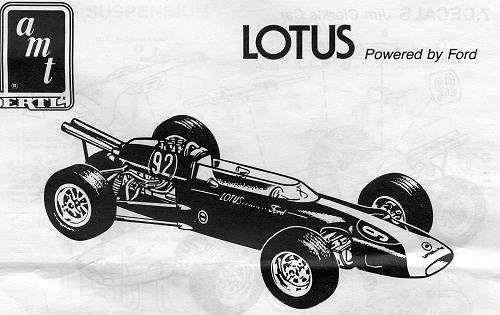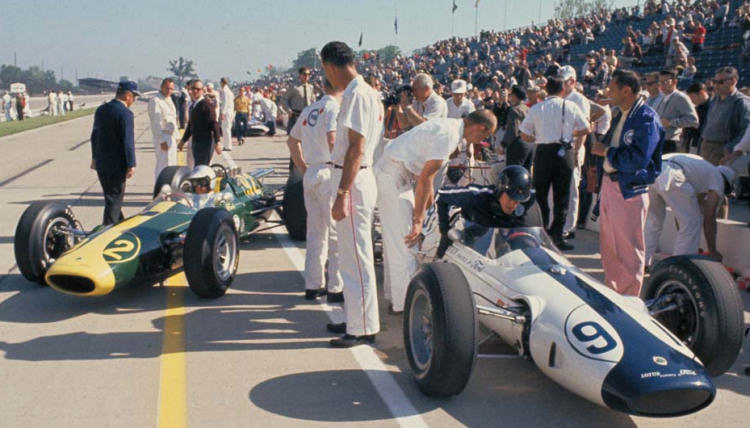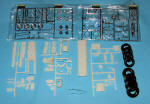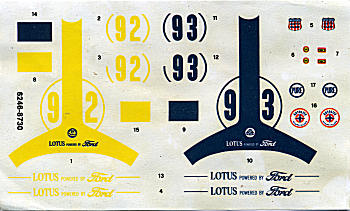
| KIT #: | ? |
| PRICE: | $? |
| DECALS: | Three options |
| REVIEWER: | Scott Van Aken |
| NOTES: | Bagged kit |

| HISTORY |
Although the 1963 Lotus 29 Indy car was memorable by being a competitive rear engine car in a field still full of front engine roadsters, it was not the first rear engine car to beraced at Indianapolis. In 1937, Lee Oldfield showed up with a rear engine car, but did not qualify it. in 1939, George Bailey did qualify a four wheel drive mid-engine car that was powered by a supercharged six cyliner engine.
It wasn't until 1961 when Jack Brabham brought a rear engine Cooper Formula One car to the race and finished well enough that the other drivers and team owners took notice of this car. Thanks to the nearly neutral weight distribution, the car was quite quick in the turns though didn't have the horsepower for good speed on the straights.
Thanks to the influence of Dan Gurney, Ford was convinced to team with Lotus to produce the Lotus 29 for the 1963 event. Two cars, one driven by Gurney and the other by Jim Clark were entered with Ford providing the engines and money while Lotus provided the cars and team organization. While the cars didn't win, Jim Clark came in second to Parnelli Jones while Dan Gurney finished seventh, both of the Lotus cars on the same lap as the winner. Two years later, in 1965, Jimmy Clark won the race in a Lotus 38 and a front engine roadster has not won at Indy since.
Below is a photo of the Jim Clark car on the left with Dan Gurney on the right. These are not large cars. Believe it or not, the seats for these cars were molded into the top of the fuel tank. The drivers were almost literally surrounded by fuel. At this time, these cars ran on gasoline as methanol was not mandated.

| THE KIT |
 This
kit was released in the mid 1960s and originally had vinyl tires. This kit has
to be one from the three car Speedway set as I got it in a bag. It has plastic
tires instead of the vinyl ones and as you might guess, they are just shapes.
The vinyl ones from the original boxing would have probably degraded long ago so
perhaps it is for the best.
This
kit was released in the mid 1960s and originally had vinyl tires. This kit has
to be one from the three car Speedway set as I got it in a bag. It has plastic
tires instead of the vinyl ones and as you might guess, they are just shapes.
The vinyl ones from the original boxing would have probably degraded long ago so
perhaps it is for the best.
The kit parts are still fairly well done. You have to realize this was a highly detailed kit for the time and we are talking about a 40 plus year old molding. There are mold seams that are a bit more than usual. There are ejector pin marks in some difficult to remove locations. Much of the kit is chrome plated so most modelers will be wanting to strip that off. Still, there are quite a few options.
One of them is to do a test car with the later 255 cubic inch double overhead cam engine that Ford used in the later Lotus 38 to finally win at Indy. Both this and the standard engine use the same block so unfortunately ,it can't be built by itself. The Lotus 29 was used as a test car for this engine, though never raced with it (at least as far as I know).
You get a full cockpit area with the seat, instrument
panel and other bits. No pedals or harness is provided. I'm sure they used a
harness by this time and you can find aftermarket racing harnesses quite easily.
The engine is very nicely done and you get all the various suspension bits and
pieces. One will have to build this kit with caution and care as AMT Indy car
kits of this era are not easy builds. Each of the eight exhaust pipes are
separate and quite complex. These lead into a collector to the two exhaust. The
body is in several sections so getting this all aligned along with the complex
suspension set up will be tricky. As mentioned, this has plastic tires which fit
on separate wheels. I find it interesting that the front and rear wheel designs
are a bit different from each other. The windscreen is the lone clear piece in
the kit.
Instructions are well done. They provide names for all the parts and some preliminary painting info, though many of the parts used are chrome. I would think that for the most part, one could paint a number of these aluminum as the photo in the instructions doesn't seem to show a lot of shine. Markings, though not in the best of shape, are for three cars. One is Jim Clark's Green with yellow trim car and the other race car is Dan Gurney's white with blue trim car. The third is an unmarked test car with the double overhead cam engine. No color information is supplied for that one at all. Thankfully, there are replacement markings available from several aftermarket sources. Just do a google to find them. The kit instructions do provide a fairly good placement guide.
| CONCLUSIONS |
I'm not sure how rare this kit actually is but it is neat and it has not been kitted by anyone else. At least not in injected plastic. If you are an Indy Car enthusiast, it is well worth seeking.
| REFERENCES |
Kit instructions as the Internet has darn little on this car.
June 2010
If you would like your product reviewed fairly and quickly, please contact me or see other details in the Note to Contributors.